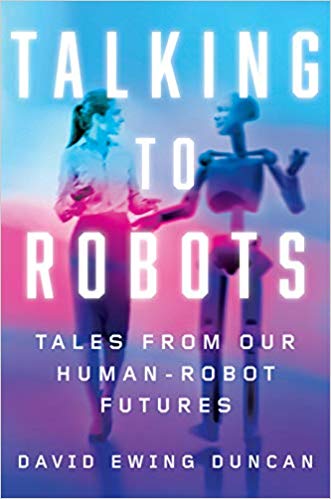 Talking to Robots: Tales from Our Human-Robot Futures by David Ewing Duncan
Talking to Robots: Tales from Our Human-Robot Futures by David Ewing Duncan
Published July of 2019.
The future isn’t what it used to be. Where we once looked forward to a Star Trekian vision of material abundance, we now worry that Lt. Commander Data is coming to take all of our jobs.
Perhaps nowhere is the fear of robot led jobless future more acute than on college campuses. The idea that the confluence of AI, IoT, big data, and cloud computing will skew the race between education and technology has taken hold of the academic mind.
Through my own unscientific and unrepresentative sampling of campus opinions, I’ve concluded that the majority of the terminally degreed believe that an era of technological unemployment is about to arrive.
Why are academics so worried about robots?
My guess is that academic robot anxiety represents a more generalizable fear that the higher ed gig is up. Every trend, from adjunctification to public disinvestment to demographic forces, seems to be an argument against building an academic career. How can professors feel good about technology the future of jobs, when their jobs feel so vulnerable?
Talking to Robots is well-timed for our current cultural moment.
In an age where many of us are convinced that many things for many people are likely to get considerably worse, Talking to Robots is helpfully written from the perspective of our not-yet-arrived future.
The author, David Ewing Duncan, adopts (or invents) a writing style of the near-future tense. The book is a creative mashup of fiction and nonfiction, in which a future narrator describes what happens after we finally progressed beyond the ERE (Early Robot Era).
Many readers of Talking to Robots will buy the book on the strength of the Sex Bot chapter alone. (And will be surprised at Duncan’s positive thinking on the role that robots might play in advancing human intimacy). The other 25 chapters not about robot sex cover everything from the future of the military (Warrior Bot) to politics (Politician Bot) to medicine (Doc Bot).
Duncan’s technique is to interview real-life technology experts, such as Kevin Kelly and Dean Kamen and Tim O’Reilly, and that work their insights into a vision of the future. (Told in the past tense). The results of this narrative technique are equal parts evocative and frustrating.
It is good to free our minds to think beyond the conventional dystopian/utopian views of technology. The reader of Talking to Robots, however, leaves the book wishing that Duncan had spread his thinking a bit less thinly. Deeper dives into the future of work, told from the vantage point of a narrator living in the future, would have been appreciated.
Too many of the chapters of Talking to Robots range too far afield after the ERE (Early Robot Era), and while fascinating from a far-future sci-fi perspective, end up being less useful as guides for those of us firmly rooted in the ERE.
Reading Talking to Robots might somewhat ease the mind of some academics about the future. Duncan seems to believe that things will mostly work out. If anything, our fear of robots - and the amplified technological anxieties of the academic world - tell us things mostly about ourselves. Our worries about a robot-led jobless future are likely manifestations of our current day fears and insecurities.
A creative mix of fiction and nonfiction, such as in Talking to Robots, might be the ideal vehicle to illuminate our current situation - even if that approach leaves us in doubt about what might be coming next.
What are your favorite robot and jobs books?
What are you reading?
https://ift.tt/2ZgX4GW
0 Response to "What Might We Learn from 'Talking to Robots'? | Technology and Learning - Inside Higher Ed"
Post a Comment